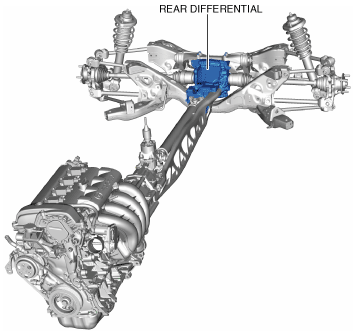REAR DIFFERENTIAL
id031400100600
Purpose, Function
• An aluminum differential carrier and an aluminum differential rear cover have been adopted, reducing weight.
• It is rigidly attached to the transmission with a power plant frame in order to enhance the feeling of direct drive when starting from a standstill and accelerating.
• For vehicles with limited slip differential (LSD), a super-LSD with a low torque bias ratio* has been adopted to improve performance when starting from a standstill, driving straight-ahead and response.
• The super-LSD is a torque-sensing type that provides improved driving stability due to the following characteristics:
-
― Low torque bias ratio provides improved controllability (torque bias ratio: 1.8) (SKYACTIV-G 1.5)
― Low torque bias ratio provides improved controllability (torque bias ratio: 2.0) (SKYACTIV-G 2.0)
― Creation of initial torque provides improved starting from a standstill and acceleration/deceleration response, and driving straight-ahead (initial torque: 49 N·m {5.0 kgf·m, 36 ft·lbf})
― Simplified construction provides weight reduction
* Torque bias ratio : When a wheel slips due to a low-traction surface, the LSD provides proportionally more torque to the opposite wheel. The torque bias ratio is the ratio of torque supplied to the right and left wheels in such cases, and represents the performance capability of the LSD.
Cross-Sectional View
Construction
Super-LSD construction
-
• Inside the super-LSD, taper rings that are fixed to the differential gear case have been placed between the differential gear case and the side gears. Additionally, a cone is provided around the outer surface of the side gear.
• Springs and retainers are positioned between the right and left side gears to provide initial torque to the taper rings.
Operation
Super-LSD operation
-
Straight ahead driving
-
• When driving straight, the right and left side gears rotate at the same speed, and the pinion and side gears rotate together with the differential gear case. Input force from the ring gear is transmitted to the pinion gears via the gear case and to the rear drive shaft via the side gears. Due to this, a speed difference between right and left in the differential does not occur.
-
Differential operation
-
• If the rotation speed between the right and left wheels becomes different (during normal driving), the pinion gears rotate together while revolving around the center axle of the rear drive shaft, thereby absorbing the difference in rotation speed. This mechanism serves as a differential.
-
Limited-slip operation
-
• If the differential encounters a condition requiring limited-slip control such as wheel spin, thrust force acts on the side gears due to the reaction force from the meshing of the pinion and side gears. This thrust force presses the side gears against the taper ring, generating friction between the side gear cone and the taper ring and reducing the torque of the slipping wheel.
• The reduced torque is transmitted without change to the wheel with higher traction, and the limited slip differential function is provided. The torque transmitted to the wheel with higher traction is proportionate to the input torque of the ring gear.
